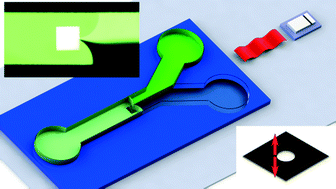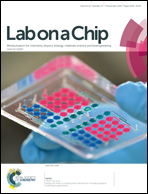Vibrating membrane with discontinuities for rapid and efficient microfluidic mixing†
Abstract
This study presents a novel acoustic mixer comprising of a microfabricated silicon nitride membrane with a hole etched through it. We show that the introduction of the through hole leads to extremely fast and homogeneous mixing. When the membrane is immersed in fluid and subjected to acoustic excitation, a strong streaming field in the form of vortices is generated. The vortices are always observed to centre at the hole, pointing to the critical role it has on the streaming field. We hypothesise that the hole introduces a discontinuity to the boundary conditions of the membrane, leading to strong streaming vortices. With numerical simulations, we show that the hole's presence can increase the volume force responsible for driving the streaming field by 2 orders of magnitude, thus supporting our hypothesis. We investigate the mixing performance at different Peclet numbers by varying the flow rates for various devices containing circular, square and rectangular shaped holes of different dimensions. We demonstrate rapid mixing within 3 ms mixing time (90% mixing efficiency at 60 μl min−1 total flow rate, Peclet number equals 8333 ± 3.5%) is possible with the current designs. Finally, we examine the membrane with two circular holes which are covered by air bubbles and compare it to when the membrane is fully immersed. We find that coupling between the holes' vortices occurs only when membrane is immersed; while with the bubble membrane, the upstream hole's vortices can act as a blockage to fluid flow passing it.


 Please wait while we load your content...
Please wait while we load your content...